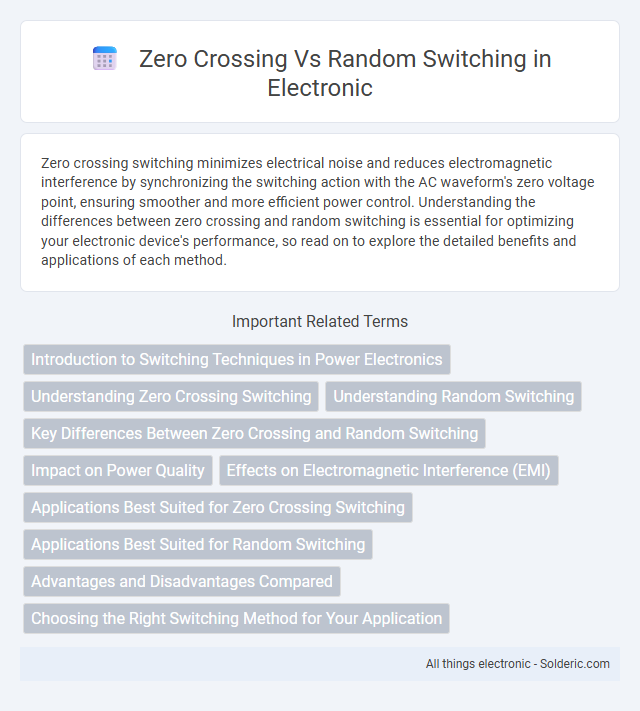Zero crossing switching minimizes electrical noise and reduces electromagnetic interference by synchronizing the switching action with the AC waveform's zero voltage point, ensuring smoother and more efficient power control. Understanding the differences between zero crossing and random switching is essential for optimizing your electronic device's performance, so read on to explore the detailed benefits and applications of each method.
Comparison Table
| Feature | Zero Crossing Switching | Random Switching |
|---|---|---|
| Definition | Switching at the zero crossing point of the AC waveform | Switching at random points in the AC waveform |
| Noise & Interference | Minimizes electrical noise and EMI | May increase electrical noise and EMI |
| Switching Loss | Low due to zero voltage/current switching | Potentially higher switching losses |
| Control Complexity | Simple timing control based on waveform zero crossing | Requires complex timing and randomization algorithms |
| Applications | Ideal for resistive loads, dimmers, and HVAC controls | Used in specialized applications requiring noise spread |
| Power Quality | Preserves power quality with minimal harmonics | May degrade power quality due to harmonic spread |
Introduction to Switching Techniques in Power Electronics
Zero crossing switching minimizes electromagnetic interference by synchronizing switching actions with the AC waveform's zero voltage point, enhancing efficiency in power electronics. Random switching distributes switching events over time, reducing specific harmonic frequencies and spreading noise energy to improve electromagnetic compatibility. Both techniques are fundamental in designing converters and inverters, balancing trade-offs between noise reduction and system complexity.
Understanding Zero Crossing Switching
Zero crossing switching reduces electrical noise by ensuring the switch operates only when the AC waveform crosses the zero voltage point, minimizing inrush current and electromagnetic interference. This technique improves the longevity of electronic components and enhances the performance of dimmers and motor controllers by preventing sudden voltage spikes. Zero crossing detection is critical in applications requiring precise timing and reduced stress on power electronics.
Understanding Random Switching
Random switching modulates power delivery by varying the timing of switching events, reducing electromagnetic interference compared to zero crossing switching, which activates signals exclusively at zero voltage points. Understanding random switching reveals its advantage in minimizing harmonic distortion and improving signal integrity in power electronics. You can enhance your device's performance and efficiency by implementing random switching techniques in applications sensitive to noise and power quality.
Key Differences Between Zero Crossing and Random Switching
Zero crossing switching occurs when the relay or switch activates precisely when the AC waveform crosses the zero voltage point, minimizing electrical noise and reducing stress on components. Random switching triggers transitions at any point in the AC cycle, which can lead to higher electromagnetic interference but allows more precise control over switching timing in certain applications. Understanding these key differences helps optimize Your circuit design for noise reduction or response accuracy based on specific operational needs.
Impact on Power Quality
Zero crossing switching minimizes electrical noise and reduces harmonic distortion by ensuring power devices switch at the voltage waveform's zero point, enhancing power quality and reducing electromagnetic interference (EMI). Random switching, while beneficial in spreading the spectral energy and decreasing audible noise, can introduce higher levels of electromagnetic interference and harmonic distortion, potentially degrading overall power quality. Careful consideration of application requirements is essential to balance noise reduction and power quality impacts between zero crossing and random switching methods.
Effects on Electromagnetic Interference (EMI)
Zero crossing switching minimizes Electromagnetic Interference (EMI) by turning the switch on or off when the AC waveform voltage crosses zero, reducing sudden current changes and voltage spikes. Random switching disperses EMI energy over a broader frequency spectrum, lowering peak interference levels but potentially increasing overall noise. Your choice between these methods depends on whether you prioritize reduced peak EMI or a wider distribution of interference frequencies.
Applications Best Suited for Zero Crossing Switching
Zero crossing switching is best suited for applications requiring reduced electromagnetic interference and minimal inrush current, such as dimmer controls, resistive heating elements, and lighting systems. Its precise timing to turn on at the voltage zero-crossing point ensures longer device lifespan and stable operation in AC power circuits. This switching method is particularly beneficial in HVAC systems, motor controls, and industrial automation where smooth power transitions are critical.
Applications Best Suited for Random Switching
Random switching is best suited for applications requiring reduced electromagnetic interference (EMI) and improved spectral performance, such as high-frequency power converters, RF communication systems, and digital audio amplifiers. Its ability to spread switching noise over a broader frequency range enhances signal integrity and minimizes peak emissions, making it ideal for sensitive electronic environments. This contrasts with zero crossing switching, which is more appropriate for resistive load control and simple lighting systems where noise reduction is less critical.
Advantages and Disadvantages Compared
Zero crossing switching minimizes electromagnetic interference (EMI) and reduces stress on electrical components by switching at the point where the AC signal crosses zero volts, making it ideal for resistive loads and improving device longevity. Random switching reduces harmonic distortion and can lower electromagnetic emissions in complex load scenarios but may increase switching losses and noise, impacting overall efficiency. Choosing between zero crossing and random switching depends on the application's sensitivity to EMI, load type, and the balance between efficiency and noise tolerance.
Choosing the Right Switching Method for Your Application
Selecting the appropriate switching method between zero crossing and random switching depends on your application's sensitivity to electromagnetic interference and switching noise. Zero crossing switching minimizes electrical noise by activating switches when the voltage waveform crosses zero, ideal for lighting and resistive loads. Random switching offers flexibility and faster response times, suitable for complex or dynamic loads where precise timing is less critical.
zero crossing vs random switching Infographic

 solderic.com
solderic.com